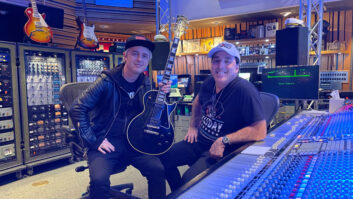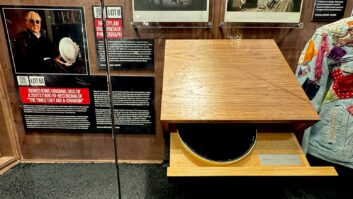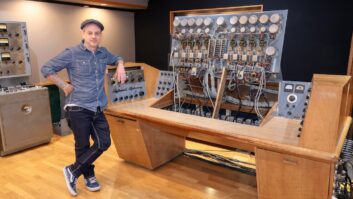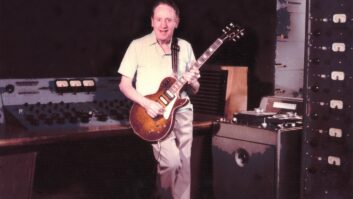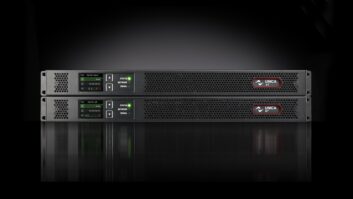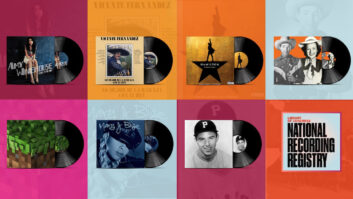Of all the tweets I’ve posted, I get the most questions on this one. People ask, “What do you mean by ‘truly stereo?’”

I think the question comes from a lack of understanding of what stereo is. So what is stereo?
It’s a pretty straightforward question with a simple answer. But let’s look at a few aspects of the subject before I answer that question.
First of all, why stereo? As you probably know, the earliest recordings were made in mono. It wasn’t by choice. It was all technology was capable of at the time. Mono wax cylinders gave way to mono wire recorders, and then mono magnetic tape.
Speaking of wire records, the great Al Schmidt told me once that wire recorders were the machines he began his career with. (Wire recorders worked basically like a magnetic tape machine. A supply and take-up spool passed a thin flexible wire across a record and playback head.) Humorously enough, with those machines you’d sequence the songs in order for the album by literally tying the ends of the wires of two songs together in a little knot!
One thing I must say, it’s remarkable to consider that a man who began his career in the 50’s with wire recorders is still widely considered one of the top engineers in the world today. Al’s recording and mixing of Diana Krall’s “Quiet Nights” is one of the best sounding records you will ever hear. And the mastering engineer, Doug Sax, told me that it was a flat transfer. No eq. No compression. A rather astounding feat.
Once magnetic tape arrived, the technology of recording in stereo was developed. By then, the vinyl LP had come on the scene, but it was also a mono device. However, forward-looking folks began to develop stereo recording techniques (particularly in classical music) and recording in stereo, knowing that at some point, stereo LPs would take over. Interestingly, those techniques are still the standard for today. No one has really discovered anything better. The Blumlein technique is a prime example as well as the M-S (Mid-Side) technique.
Pop music was something altogether different. Most of the early stereo mixes for pop music weren’t really stereo in a true sense like the classical recordings (Two or three mics capturing a single source, creating a stereo field). Most were really a kind of discrete mono. Some mixes would have a bass and guitar coming from one speaker, drums and piano or whatever from the other, and a vocal in the middle…sometimes.
It can be easily argued that the real ground-breakers in the creation of stereo pop music were the Beatles and the Beach Boys. Of course, others were doing it as well, but these guys were the leaders. Some of the early Beatles albums were released with these “discrete mono” mixes, but that was never the intention of the group, thus the remixing of those albums in mono by Geoff Emerick and George Martin a few years ago. Back in those days, AM radio was king, and mono mixes were where the most attention was given during mixdown. It’s interesting to think of this. While the classical world was recording away in stereo, AM radio kept pop music continuing to bow to the mono god.
Okay…there’s the history lesson for today. Now about this thing stereo….
Stereo is really the most natural format to listen to music for the obvious reason that we hear in stereo. Stereo fits the natural sensibilities of our species. Our two ears localize sound sources from the environment we’re in. When we hear a sound on our left side, the left ear hears it ever so slightly first, and with a bit more clarity. The right side hears it as well, but a bit later in time and with less high frequency information and with more reflections. Our brain is amazingly capable of interpreting these time delays and frequency differences and giving us the ability to very accurately determine where a sound source is. With one ear, it’s much more difficult to do that. Similarly, in an anechoic chamber, you’d not be able to easily localize a sound source, as there are no reflections giving you those spatial clues.
So, to the original question…What is stereo? The answer is essentially this: Mono is the exact same thing in both speakers. Stereo is anything else.
Some stereo recordings, such as an acoustic guitar, can sound very stereo or somewhat mono depending on how it was mic’d. When it’s not very wide, I call that “The big mono.” That means that while it was recorded with two mics or a stereo mic panned left and right, the image appears almost purely up the middle between the speakers. Maybe not totally dead center as recorded with a single mono mic, but not a wide stereo image. Now on a singer/songwriter album where very few other instruments are playing, such as a James Taylor album, that can sound fantastic. The guitar is a bit wide and the singer sits inside the stereo field. Such an approach is good and gives space for the vocal to be reside.
However, there are times when I’ll be mixing a song with tons of instruments and a guitar was recorded in that “big mono.” While it may have sounded good on the tracking date, at this point in time, that spacious stereo field is lost. With all that other instrumentation taking up space, the stereo guitar gets lost in the arrangement.
Other times I’ll get a so-called stereo synth patch…but it’s really mono but recorded on two tracks. I get it. As an engineer, you’re taking the two outputs of the source and the programmer of the sound just didn’t make a wide stereo image. It’s close to mono, or in some cases, pure mono. In these circumstances, like the stereo guitar mentioned above, I’ll delete one side and pan it wherever it makes sense. I don’t need both tracks, and don’t need it eating up DSP or faders.
So at least for me, if the sound isn’t really stereo—i.e. I can’t really hear a decently wide image in the stereo field that makes sense for the mix—I’ll not record in stereo. There’s simply no point. And similarly, if I’m recording a very densely produced track, I’ll be very careful about recording in stereo, even if it’s a nice and wide sound. You need to use your ears and hear if it’s useful to record that way. And you don’t need to leave every decision to the mixer. Get some guts and make a choice. Nine times out of ten, you’ll make the right one.
David Schober is an Engineer/Producer with 20-plus years working with the best in the biz, here to help with your recording and production needs. Find him at his website and on Twitter, or leave a comment below.
